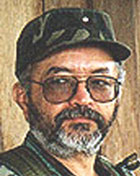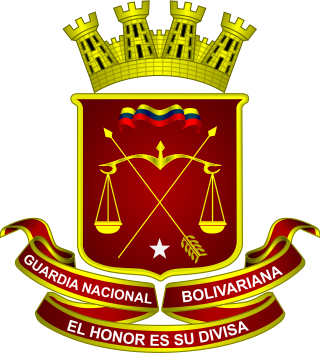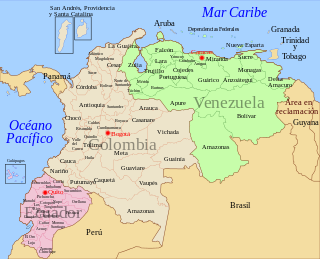
Apure State is one of the 23 states of Venezuela. Its territory formed part of the provinces of Mérida, Maracaibo, and Barinas, in accordance with successive territorial ordinations pronounced by the colonial authorities. In 1824 the Department of Apure was created, under jurisdiction of Barinas, which laid the foundations for the current entity. In 1856 it separated from Barinas and for the first time Apure appeared as an independent province, which in 1864 acquired the status of state. In 1881, however, a new territorial division combined Apure and Guayana to form a single state named Bolívar. In 1899 it reestablished its autonomy and finally, by means of the Constitution of 1909, gained its current borders.

Táchira State is one of the 23 states of Venezuela. The state capital is San Cristóbal.

San Cristóbal is the capital city of the Venezuelan state of Táchira. It is located in a mountainous region of Western Venezuela. The city is situated 818 metres (2,684 ft) above sea level in the northern Andes overlooking the Torbes River, 56 kilometres (35 mi) from the Colombian border. San Cristóbal was founded on March 31, 1561, by Juan de Maldonado. From its inception, the city evolved rapidly as one of the most progressive and important centers of commerce in the country and the region, due primarily to its rich soil and its proximity to the border with Colombia.

The National Liberation Army is a guerrilla insurgency group involved in the continuing Colombian conflict, which has existed in Colombia since 1964. The ELN advocates a composite communist ideology of Marxism–Leninism and liberation theology. In 2013, it was estimated that the ELN forces consisted of between 1,380 and 3,000 guerrillas. According to former ELN national directorate member Felipe Torres, one-fifth of ELN supporters have taken up arms. The ELN has been classified as a terrorist organization by the governments of Colombia, the United States, Canada, New Zealand, and the European Union.

Ramón José Velásquez Mujica was a Venezuelan politician, historian, journalist, and lawyer. He served as the president of Venezuela between 1993 and 1994.

San Antonio del Táchira is a city in the Venezuelan Andean state of Táchira. The busy highway across the Simón Bolívar International Bridge linking the cities of Cúcuta, Colombia, and San Cristóbal, Venezuela, passes through San Antonio del Táchira, making it an important gateway between the two nations. This city is the shire town of the Municipio Bolívar de Táchira and, according to the 2001 Venezuelan census, the municipality has a population of 48,171.

Luis Edgar Devia Silva, better known by his nom de guerreRaúl Reyes, was a leader, Secretariat member, spokesperson, and advisor to the Southern Bloc of the Revolutionary Armed Forces of Colombia–People's Army (FARC–EP). He died during an attack by the Colombian army 1.8 kilometres (1.1 mi) within Ecuador, sparking the 2008 Andean diplomatic crisis involving Ecuador, Colombia and Venezuela.

Jorge Jesús Rodríguez Gómez is a Venezuelan politician and psychiatrist serving as President of the National Assembly of Venezuela since 2021. He previously served as the vice president of Venezuela from 2007 to 2008 and as Mayor of the Libertador Bolivarian Municipality from 2009 to 2017. He is the brother of Delcy Rodríguez, the current vice president.

The Bolivarian National Guard of Venezuela, is a gendarmerie component of the National Armed Forces of Venezuela. The national guard can serve as gendarmerie, perform civil defense roles, or serve as a reserve light infantry force. The national guard was founded on 4 August 1937 by the then President of the Republic, General-in-Chief Eleazar López Contreras. The motto of the GNB is "El Honor es su divisa", slightly different from the motto of the Spanish Civil Guard "El Honor es mi divisa".

Colombia–Venezuela relations refers to the diplomatic relations between the South American neighboring countries of Colombia and Venezuela. The relationship has developed since the early 16th century, when Spanish colonizers created the Province of Santa Marta and the Province of New Andalucia. The countries share a history of achieving their independence under Simón Bolívar and becoming one nation—the Gran Colombia—which dissolved in the 19th century. Since then, the overall relationship between the two countries has oscillated between cooperation and bilateral struggle.

The 2008 Andean diplomatic crisis was a diplomatic stand-off involving the South American countries of Ecuador, Colombia and Venezuela. It began with an incursion into Ecuadorian territory across the Putumayo River by the Colombian military on March 1, 2008, leading to the deaths of over twenty militants, including Raúl Reyes and sixteen other members of the Revolutionary Armed Forces of Colombia (FARC). This incursion led to increased tension between Colombia and Ecuador and the movement of Venezuelan and Ecuadorian troops to their borders with Colombia.
The timeline of some of the most relevant events in the Mexican drug war is set out below. Although violence between drug cartels had been occurring for three decades, the Mexican government held a generally passive stance regarding cartel violence through the 1980s and early 2000s.
Roberto Antonio Giusti Aranguren was a Venezuelan journalist. He worked at numerous newspapers including El Nacional and El Universal. He wrote a lot of books including Yo Lo Viví, Memorias Inconclusas, and Pasión Guerrilla. He worked for Globovisión TV and was the host of Primera Página and Grado 33.
The 2010 San Fernando massacre, also known as the first massacre of San Fernando, was the mass murder of 72 undocumented immigrants by the Los Zetas drug cartel in the village of El Huizachal in the municipality of San Fernando, Tamaulipas, Mexico. The 72 killed—58 men and 14 women—were mainly from Central and South America, and they were shot in the back of the head and then piled up together. The bodies were found inside a ranch on 24 August 2010 by the Mexican military after they engaged in an armed confrontation with members of a drug cartel. They received information of the place after one of the three survivors survived a shot to the neck and face, faked his death, and then fled to a military checkpoint to seek help. Investigators later mentioned that the massacre was a result of the immigrants' refusal to work for Los Zetas, or to provide money for their release.

Los Rastrojos is a Colombian drug cartel and paramilitary group engaged in the Colombian armed conflict. The group was formed by Norte del Valle cartel capo Wilber Varela, alias "Jabón" and one of his right-hand men, "Diego Rastrojo", around 2004 when Varela fell out with fellow-capo Diego Leon Montoya, alias "Don Diego". The group became independent after the murder of its main founder in Venezuela in 2008 and at its height was one of the most important drug trafficking organizations in Colombia.

The 2015 Colombia–Venezuela migrant crisis refers to a diplomatic and humanitarian crisis that occurred in mid-2015 following the shooting of three Venezuelan soldiers on the Venezuela–Colombia border that left them injured and President of Venezuela Nicolás Maduro's response of deporting thousands of Colombians. Maduro's response of declaring a state of emergency, closing the border to Colombia indefinitely and deporting thousands of Colombians that lived near the border, struck fear in tens of thousands of other Colombians living in Venezuela resulting in their emigration from the country and a crisis involving separated families and Colombians seeking food and shelter. The actions of President Maduro were questioned by human rights groups, the United Nations, the European Union and the United States.
The following lists events in the year 2017 in Venezuela.
The following lists events that happened during 2018 in Venezuela.

The Pemon conflict is an ongoing conflict which is a part of the wider Crisis in Venezuela. The conflict is centered around mining disputes between the Maduro government, the Pemon nation and armed irregular groups. The Pemon nation is divided by the border between Venezuela and Brazil, resulting in Pemon refugees regularly crossing the border into Brazil for safety and medical care. The conflict is centred on disputes over mining in the Orinoco Mining Arc, a 112,000 km2 area of the Amazon Rainforest rich in gold, diamonds, coltan, and uranium, which are also home to the Pemon people.
The following lists events in the year 2022 in Venezuela.














